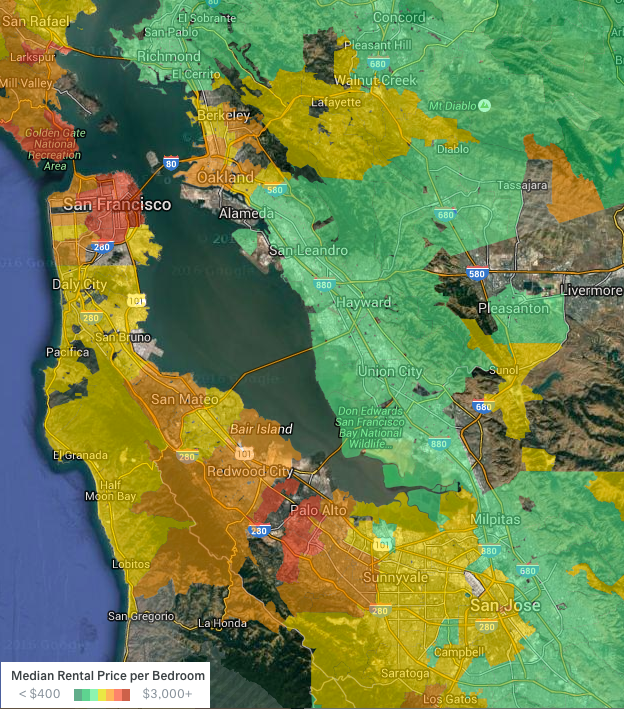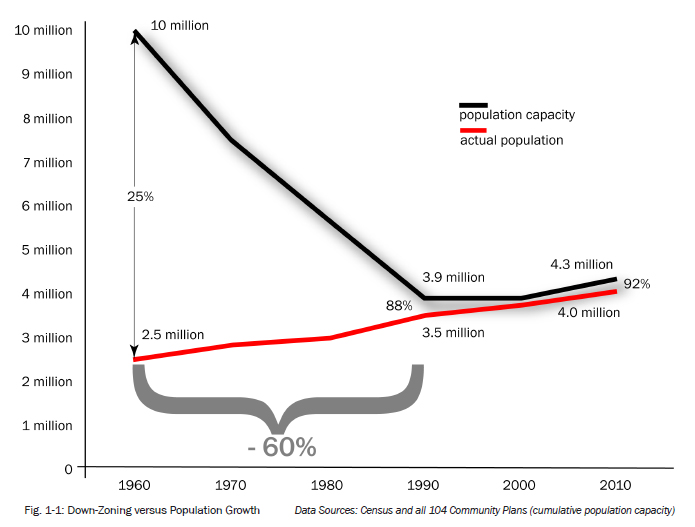Physical Address
304 North Cardinal St.
Dorchester Center, MA 02124
Physical Address
304 North Cardinal St.
Dorchester Center, MA 02124

[Editor’s note–this is the inaugural article for a new blog that Jeff launched called Tech For Housing, where tech workers advocate for more housing in the Bay Area.] San Francisco–For decades, every city in the Bay Area has restricted housing production. And for decades, the Bay Area has gone deeper into housing debt. People and money continue streaming into the region, cities rarely allow new housing, and prices continue to rise. This hurts every industry in the Bay Area, and tech is no exception. The housing market steals money straight out of our pockets and, if we stay the current course, will rob us of the better version of ourselves we need more time to become. How Housing Robs Us Blind Housing in San Francisco costs 73% more than in Austin, 53% more than in Seattle, and 36% more than in Los Angeles. And figures for many of the Peninsula Cities are even worse. After accounting for cost of living, our real incomes in Bay Area tech are often lower than those of our colleagues in less expensive locales simply by virtue of housing costs. Obviously, this is bad for us as employees, but it hurts founders and investors as well. The higher housing prices climb, the more founders have to pay employees to provide for the same standard of living. And the higher labor costs become, the more money founders have to raise from investors, meaning more capital gets tied up funding the same amount of work. All this adds up to tech, as an industry, paying more and more to stay in the Bay Area for zero added benefit. Median Rental Price per Bedroom Source: Trulia But there’s more at stake than just burn rates and take-home pay. As it stands, housing prices are a millstone around our […]
One common argument against building new housing is that new construction will never reduce housing costs, because the influx of ultra-rich people into high-cost cities creates an insatiable level of demand. I recently found a source of information that may be relevant to this argument: the Wealth Report, which lists the number of high-wealth individuals in a set of world cities, including five American cities (New York, Los Angeles, Chicago, Houston and Miami). In particular, the report lists the number and percentage growth of “ultra high net worth individuals” (UHNWIs), which it defines as those with over $30 million in wealth. It seems to me that if UHNWI growth was related to high housing costs, then the most expensive cities in this group (New York and Los Angeles) would have the highest UNHWI growth. In fact, the number of UHNWIs grew most rapidly in Houston (63 percent) between 2005 and 2015. By contrast, UNHWI growth in the other four cities ranged between 31 and 34 percent. In Canada, UNHWI growth was higher, but roughly equal (ranging between 65 and 70 percent) in Toronto, Vancouver and Montreal- despite the fact that these cities have radically varying housing costs. The median housing unit price in Vancouver tops $1 million, about three times the median price in Montreal. What about UNHWIs as a percentage of city population? New York has 5600 of them in a city of 8.1 million*- just under 700 per 1 million. Low-cost Chicago has 2030 in a city of 2.7 million- about 750 per 1 million. Houston has 1318 in a city of 2.1 million, or around 625 per million. These differences don’t strike me as significant. *I am assuming these people all live in the central city; I am not actually sure this is the case, […]
[Research help for this article was provided by UCLA student Mitchell Boswell] The past 15 years have seen a hell of a lot of gentrification in LA. 15% of our poor neighborhoods have undergone gentrification since the year 2000, and it feels like things have only accelerated since the end of the financial crisis. That’s putting a huge strain on communities across the city, from Boyle Heights to Leimert Park. But before we get into why, let’s get one thing out of the way… Academics love to debate about whether gentrification is good or bad for residents of poor neighborhoods. Maybe we should try listening to what people actually want. Some argue that when a neighborhood gentrifies, more of the existing residents stay in the neighborhood than they otherwise would (one of the many, many hard things about poverty is housing insecurity, so folks tend to move around a lot no matter what), and also tend to be more satisfied after the change. On the other side of the debate are people arguing that as gentrification occurs, the investment and new residents push up rent prices and drive out poor residents who made that community home. It’s not clear who’s right. That all seems pretty academic – it’s an argument between folks who are well-off about whether or not people in poor neighborhoods should be happy. Instead of telling people how they should feel, maybe we should stop and listen, just for a minute, to what they want. And a lot of those people sure as hell don’t seem to want gentrification. The lack of new housing on the Westside is driving gentrification There are a lot of reasons for gentrification, but the lack of new housing on the Westside deserves a lot of the blame in recent years. As […]
One common argument against allowing the construction of taller apartment buildings is that tall buildings cost more to build, and thus are “overwhelmingly occupied by the wealthy.” For example, tall buildings, unlike houses and walk-up buildings, require elevators. But in fact, fairly tall buildings can be pretty cheap where demand is low and/or housing supply is high. For example, in East Cleveland, a low-income suburb of Cleveland, one 24-story building rents one bedroom apartments for as little as $552 per month, despite the fact that the building contains extras such as a pool and a fitness center. This means that (assuming rent should be no more than a quarter of income) someone earning less than $30,000 could afford this building. Even in nicer neighborhoods, older high-rises are not hugely expensive: for example, in midtown Atlanta, the Darlington’s apartments start at just over $700. It could be argued that because these buildings were built decades ago, their costs are not relevant to those of newer buildings. Certainly, newer high-rises are more expensive than older ones- but the same is true for newer walk-ups. To test this proposition, I focused on the outer boroughs of New York, using Zillow.com to focus on buildings built between 2010 and 2016. The cheapest newer apartment in Brooklyn started at $1150 (about $350 more than the cheapest older listing); the cheapest new elevator building started at $1600 (and included a doorman, thus inflating the rent beyond the basic amount caused by elevators). Similarly, in Queens the cheapest newer building rented for $1450 (over $600 more than the cheapest older listing), while the cheapest newer elevator building rented for $1550. In sum, it seems to me that the difference in cost between the cheapest high-rises and the cheapest low-rises, although not nonexistent, are not huge either.
On Thursday, the Massachusetts State Senate voted 23-15 to pass the zoning reform bill, S.2311, after approximately three hours of debate and amendments. 20 of the 63 amendments were adopted, with the rest either defeated or withdrawn. According to the Massachusetts Smart Growth Coalition, the bill directs municipalities to allow accessory dwelling units as-of-right in single-family residential districts; permits more as-of-right multifamily housing; reduces the number of votes needed to change zoning from a two-thirds majority to a simple majority; allows development impact fees; eliminates the need for special permits for some types of zoning; provides standards for granting zoning variances; establishes a training program for zoning board members; and lastly, modifies the process of creating a subdivision. One amendment that was defeated, proposed by Sen. William Brownsberger, removed a provision that would have required cities with an inclusionary zoning policy to offer concessions such as density bonuses. A provision from the first Senate version of the bill, S. 122, that would have allowed for consolidated permitting, was not enacted. Unlike past ones, this bill actually has teeth: the as-of-right multifamily provision establishes a minimum density of 8 units per acre for rural communities and 15 for others and if municipalities don’t comply, courts can provide relief. The bill was passed despite last-minute attempts to derail it by Sen. Bruce Tarr (R-Essex and Middlesex), who attempted to have it sent back to the Ways and Means Committee on the grounds that it had no public hearings since last September. This was rejected by the other senators, with Sen. Dan Wolf (D-Barnstable) saying he wished every bill was as fully vetted as S.2311. “We have fully vetted this, we are ready to move,” he said. “We need to update outdated zoning laws,” said Sen. Harriette Chandler (D-Worcester). “To recommit will serve nothing but […]

In 1986, a foreshadowing of today’s fight over “neighborhood integrity” was taking place, culminating in November as Los Angeles residents voted 2-to-1 to cut the development potential of thousands of parcels across the city. Of the 29,000 acres zoned for commercial and industrial uses throughout LA, 70 percent saw their development capacity sliced in half, from a floor-area ratio (FAR) of 3.0 to 1.5. Since the city allows housing to be built in many of these zones, it didn’t just mean less office, retail, and manufacturing space, but fewer homes as well. The ballot initiative responsible for these changes was called Proposition U, and it’s the reason that so many commercial corridors in LA are still characterized by 1960s and ’70s-era, single-story, dilapidated strip malls. All those arterial corridors were the ones permanently frozen in time by Prop U. THE PROPOSAL To my knowledge no one has ever assessed exactly how much this instance of “planning by the ballot” actually reduced the residential capacity of Los Angeles. By my very, very rough estimate, I would put the number somewhere on the order of 1 million homes.* But whether the actual number is 1 million, 500K, or over 2 million, the conclusion is the same: If we want to keep Los Angeles affordable for residents at all income levels, we should repeal Proposition U. Repealing Proposition U would achieve several important aims. Since we’re talking about arterial, commercial corridors, the repeal would dramatically increase the supply of transit-oriented housing over the next several decades—something we desperately need at a time of record-low residential vacancy rates if we’re to have any hope of limiting continued rent increases. It would reduce development pressures on existing communities, directing development to underutilized corridors with little to no housing on them, rather than funneling developers into single-family neighborhoods […]

A metropolitan economy, if it is working well, is constantly transforming many poor people into middle-class people, many illiterates into skilled people, many greenhorns into competent citizens. … Cities don’t lure the middle class. They create it. – Jane Jacobs, The Death and Life of Great American Cities If you follow urban issues in the press, you might be forgiven for thinking that there are only three cities in America: San Francisco, New York, and Portland. All three are victims of their own success, as rising demand for housing has increased rents to unsustainable levels. Despite their best efforts, from rent control to inclusionary zoning mandates, middle- and lower-class households are increasingly forced to leave these cities as each progressively transforms into a playground of the rich. Yet there is a fourth city, a city which must not be named except to be derided as a sprawling, suburban hellscape. This fourth city has managed to balance a booming economy, explosive population growth, and affordable housing. This city has—as cities have for thousands of years—steadily grown denser, more walkable, and more attractive to low-income migrants seeking opportunity. This city is Houston, and it’s well past time for her to come out of the shadows. Explosive Economic Growth, Booming Population, Functioning Housing Market Before jumping into the nitty-gritty of how Houston has handled explosive growth in the demand for housing, it is worth first getting a handle on the magnitude of the challenge facing the city. When many people think of the Houston economy, they understandably think of large energy companies. Indeed, energy companies dominated Houston’s economy for much of the last century and continue to play a major role today. But in the years following the 1980s oil glut, Houston’s economy has been diversified in large part by startups and emerging small […]
[Research help for this article was provided by UCLA student Hunter Iwig] The rent in LA has gone up 30% in the last three years. What the hell? Three big things happened, two of them awesome, and one dumb. We decided living in cities was cool again (awesome), city centers are creating tons of new jobs (awesome), and we didn’t build very many new places to live in our cities (not awesome). Living in cities is cool again (awesome) In the 1950s and 1960s our cities stopped growing and people started moving to the suburbs. We kept it up for a long, long time. But something has changed in the last 10-15 years. More and more people prefer to live in walkable, urban areas. Today, 52% of Americans say they would like to live in a place where they do not need to use a car very often. For millennials, it’s even higher – 63% say they want the walkable convenience of cities. City dwellers do less environmental damage and cause less traffic, so that sounds like pretty damn good news. Cities are creating tons of jobs (awesome) New jobs used to be created in suburbs. But since the Great Recession until 2011, that’s changed – cities are where the new jobs are. And, surprise surprise, people want to move to places where they can get jobs. We’ve made it incredibly hard to build more houses in LA and other cities (not awesome) First, a quick primer. You can’t build anything you want wherever you want. Zoning and planning rules dictate what can be built on any given plot of land. In 1960, L.A. had a population of 2.5 million, but its zoning rules allowed for housing for 10 million if every lot was built to it’s maximum density. Today our […]
If you read elite commentary on the home-sharing industry (that is, Airbnb and its competitors), especially on the Left, you might think it is quite controversial. However, a recent Pew survey suggests otherwise. According to Pew, very few people know very much about home-sharing. Only 11 percent of Americans have used home-sharing services, and 53 percent of all adults have never even heard of them. Only 9 percent of Americans claim to have heard “a lot” about the homesharing debate, and 16 percent have heard “a little.” Among people who have actually used home-sharing services, these numbers rise to 19 percent and 37 percent. But to the extent Americans are aware of home-sharing, they like the idea. Only 4 percent of Americans think home-sharing should be illegal, and only 30 percent think it should be taxed. 52 percent think homesharing should be legal and untaxed. Even among self-described liberals, only 38 percent think homesharing should be taxed.

Curitiba One recent urban planning trend advocates for so-called “Transit-Oriented Developments”, or TODs. This is when cities allow already built-up areas to increase development along mass transit corridors, such as bus or rail lines. If such transit infrastructure didn’t exist, the potential development increase in these areas would be restricted. The TOD idea is mainly based on the Curitiba model, a city that allowed denser building and populations along Bus Rapid Transit (BRT) corridors. The above image shows the effects: high-rise buildings with minimum or absent setbacks along the corridors, and sharp decreases in density on adjacent streets, since these latter streets would theoretically use the BRTs less. The same logic is being applied for São Paulo’s new recently-approved Zoning Code: sharp density increases in allowed built-up areas along mass transit corridors, and more low-slung buildings further into the neighborhoods. This TOD model is certainly better than previous ones, wherein dense development was restricted altogether, even when near mass transit. As I’ve previously noted, lower densities undermine the economic feasibility of transit networks, which rely on intense agglomerations. Many factors justify TODs’ attractiveness to current planners, including that they make transit viable, increase the centrally-located housing stock, and satisfy residents of low-rise areas, who usually enjoy keeping their neighborhoods’ original features. But I haven’t become a broad advocate of TODs because they disproportionately favor these low-rise residents, disregarding everyone who must be pushed into suburban peripheries. A TOD-driven approach has a correct logic of analyzing neighborhood scale, and trying to organize it likewise, based on transit and street availability. But it doesn’t account for the factthat every unit left unbuilt within a neighborhood will necessarily be built in the outskirts, generating longer commutes and higher infrastructure costs. Peripheral residents certainly are not the same as downtown ones, but they would still […]